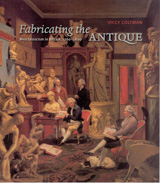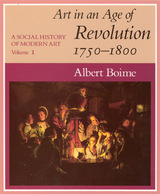2 books about Neoclassicism (Art)

Fabricating the Antique
Neoclassicism in Britain, 1760-1800
Viccy Coltman
University of Chicago Press, 2006
Between 1760 and 1800, British aristocrats became preoccupied with the acquisition of ancient Greek and Roman artifacts. From marble busts to intricately painted vases, these antiquities were amassed in vast collections held in country houses and libraries throughout Britain. In Fabricating the Antique, Viccy Coltman examines these objects and their owners, as well as dealers, restorers, designers, and manufacturers. She provides a close look at the classical revival that resulted in this obsession with collecting antiques.
Looking at the theoretical foundations of neoclassicism, Coltman contends this reinvention of ancient material culture was more than a fabrication of style. Based in the strong emphasis on classical education during this time, neoclassicism, Coltman claims, could be more accurately described as a style of thought translated into material possessions. Fabricating the Antique is a new take on both well-known collections of ancient art and newly cataloged artifacts. This book also covers how these objects—once removed from their original context—were received, preserved, and displayed. Art historians, classicists, and archaeologists alike will benefit from this important examination of British eighteenth-century history.
Looking at the theoretical foundations of neoclassicism, Coltman contends this reinvention of ancient material culture was more than a fabrication of style. Based in the strong emphasis on classical education during this time, neoclassicism, Coltman claims, could be more accurately described as a style of thought translated into material possessions. Fabricating the Antique is a new take on both well-known collections of ancient art and newly cataloged artifacts. This book also covers how these objects—once removed from their original context—were received, preserved, and displayed. Art historians, classicists, and archaeologists alike will benefit from this important examination of British eighteenth-century history.
[more]

A Social History of Modern Art, Volume 1
Art in an Age of Revolution, 1750-1800
Albert Boime
University of Chicago Press, 1987
In A Social History of Modern Art, a sweeping multivolume social history of Western art from the French Revolution to World War I, Albert Boime moves beyond the concern with style and form that has traditionally characterized the study of art history and, in the tradition of Arnold Hauser, examines art in a broad historical context. Into his wide-ranging cultural inquiry Boime incorporates not only frequently studied mainstream artists and sculptors but also neglected and lesser known artists and unattributed popular imagery. He examines popular as well as official culture, the family as well as the state, and the conditions of the poor as well as of the affluent that affected cultural practice.
This inaugural volume explores the artistic repercussions of the major political and economic events of the latter half of the eighteenth century: the Seven Years' War, the French Revolution, and the English industrial revolution. Boime examines the prerevolutionary popularity of the rococo style and the emergence of the cult of antiquity that followed the Seven Years' War. He shows how the continual experiments of Jacques-Louis David and others with neoclassical symbols and themes in the latter part of the century actively contributed to the transformation of French and English politics. Boime's analyses reveal the complex relationship of art with a wide range of contemporary attitudes and conditions—technological innovation, social and political tensions, commercial expansion, and the growth of capitalism.
"Provocative and endlessly revealing."—Christopher Knight, Los Angeles Herald Examiner
This inaugural volume explores the artistic repercussions of the major political and economic events of the latter half of the eighteenth century: the Seven Years' War, the French Revolution, and the English industrial revolution. Boime examines the prerevolutionary popularity of the rococo style and the emergence of the cult of antiquity that followed the Seven Years' War. He shows how the continual experiments of Jacques-Louis David and others with neoclassical symbols and themes in the latter part of the century actively contributed to the transformation of French and English politics. Boime's analyses reveal the complex relationship of art with a wide range of contemporary attitudes and conditions—technological innovation, social and political tensions, commercial expansion, and the growth of capitalism.
"Provocative and endlessly revealing."—Christopher Knight, Los Angeles Herald Examiner
[more]
READERS
Browse our collection.
PUBLISHERS
See BiblioVault's publisher services.
STUDENT SERVICES
Files for college accessibility offices.
UChicago Accessibility Resources
home | accessibility | search | about | contact us
BiblioVault ® 2001 - 2024
The University of Chicago Press









